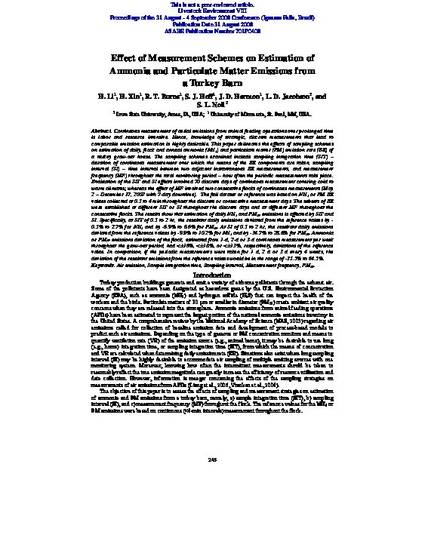
Continuous measurement of aerial emissions from animal feeding operations over prolonged time is labor and resource intensive. Hence, knowledge of strategic, discrete measurements that lead to comparable emission estimation is highly desirable. This paper delineates the effects of sampling schemes on estimation of daily, flock and annual ammonia (NH3) and particulate matter (PM) emission rate (ER) of a turkey grow-out house. The sampling schemes examined include sampling integration time (SIT) – duration of continuous measurement over which the means of the ER components are taken, sampling interval (SI) – time interval between two adjacent instantaneous ER measurements, and measurement frequency (MF) throughout the total monitoring period – how often the periodic measurements take place. Evaluation of the SIT and SI effects involved 70 discrete days of continuous measurement covering cold to warm climates; whereas the effect of MF involved two consecutive flocks of continuous measurements (May 2 – December 17, 2007 with 7-day downtime). The full dataset or reference was based on NH3 or PM ER values collected at 0.5 to 4 min throughout the discrete or consecutive measurement days. The subsets of ER were established at different SIT or SI throughout the discrete days and at different MF throughout the consecutive flocks. The results show that estimation of daily NH3 and PM10 emissions is affected by SIT and SI. Specifically, at SIT of 0.5 to 2 hr, the resultant daily emissions deviated from the reference values by -0.5% to 2.7% for NH3 and by -6.9% to 6.6% for PM10. At SI of 0.5 to 2 hr, the resultant daily emissions deviated from the reference values by -9.9% to 10.2% for NH3 and by -34.7% to 28.8% for PM10. Ammonia or PM10 emissions deviation of the flock, estimated from 1-d, 2-d or 3-d continuous measurement per week throughout the grow-out period, had <±16%, <±18%, or <±13%, respectively, deviations of the reference value. In comparison, if the periodic measurements were taken for 1 d, 2 d or 3 d every 4 weeks, the deviation of the resultant emissions from the reference values would be in the range of -35.5% to 64.5%.
Available at: http://works.bepress.com/steven_hoff/9/

This proceeding is from Livestock Environment VIII, 31 August–4 September 2008, Iguassu Falls, Brazil. Paper No. 701P0408.